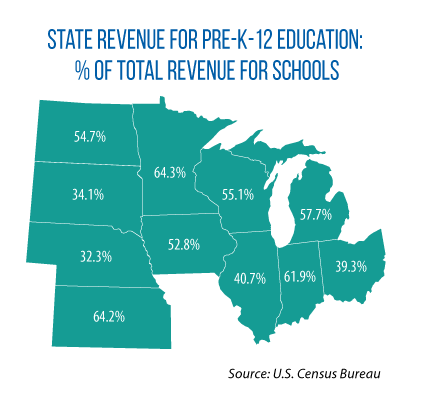How much? Where from? A Look at how state education systems are funded in Midwest
July 21, 2021
|
Per pupil spending in the nation’s pre-K-12 education system now eclipses $13,000, and in four Midwestern states — Illinois, Minnesota, Ohio and North Dakota — these levels are even higher, according to data released in May by the U.S. Census Bureau. The new data also shed light on other notable trends and differences in this critical issue area for state governments. For example:
Minnesota, Ohio and North Dakota — these levels are even higher, according to data released in May by the U.S. Census Bureau. The new data also shed light on other notable trends and differences in this critical issue area for state governments. For example:
- In fiscal year 2019, per pupil expenditures in the Midwest ranged from a high of $16,227 in Illinois to a low of $10,139 in South Dakota. These amounts include federal, state and local government spending. All of the biggest-spending U.S. states are in the Northeast. (New York tops the list, at $25,139 per pupil; Idaho has the lowest spending level, $7,985 per student.)
- The sources of revenue for pre-K-12 schools are the same across the states: local, state and federal. However, considerable variations exist in how much these sources account for total revenue collections. For example, in the Midwest, state-based revenue (from income taxes, sales taxes, etc.) accounted for 64 percent of total collections for pre-K-12 schools in Kansas and Minnesota. In contrast, states such as Illinois, Nebraska, Ohio and South Dakota are more reliant on local sources of revenue such as property taxes (see map).
- Overall K-12 spending in FY 2019 (the year before the COVID-19 pandemic) rose 4.7 percent over the previous year. No state in the Midwest matched this rate of growth; Ohio came closest (4.6 percent). The Census Bureau data show that overall pre-K-12 expenditures fell in Illinois, Nebraska and South Dakota between FY 2018 and 2019. Spending on elementary and secondary education makes up the single largest amount of U.S. states’ general fund budgets, 35.5 percent of expenditures in fiscal year 2020, according to the National Association of State Budget Officers.